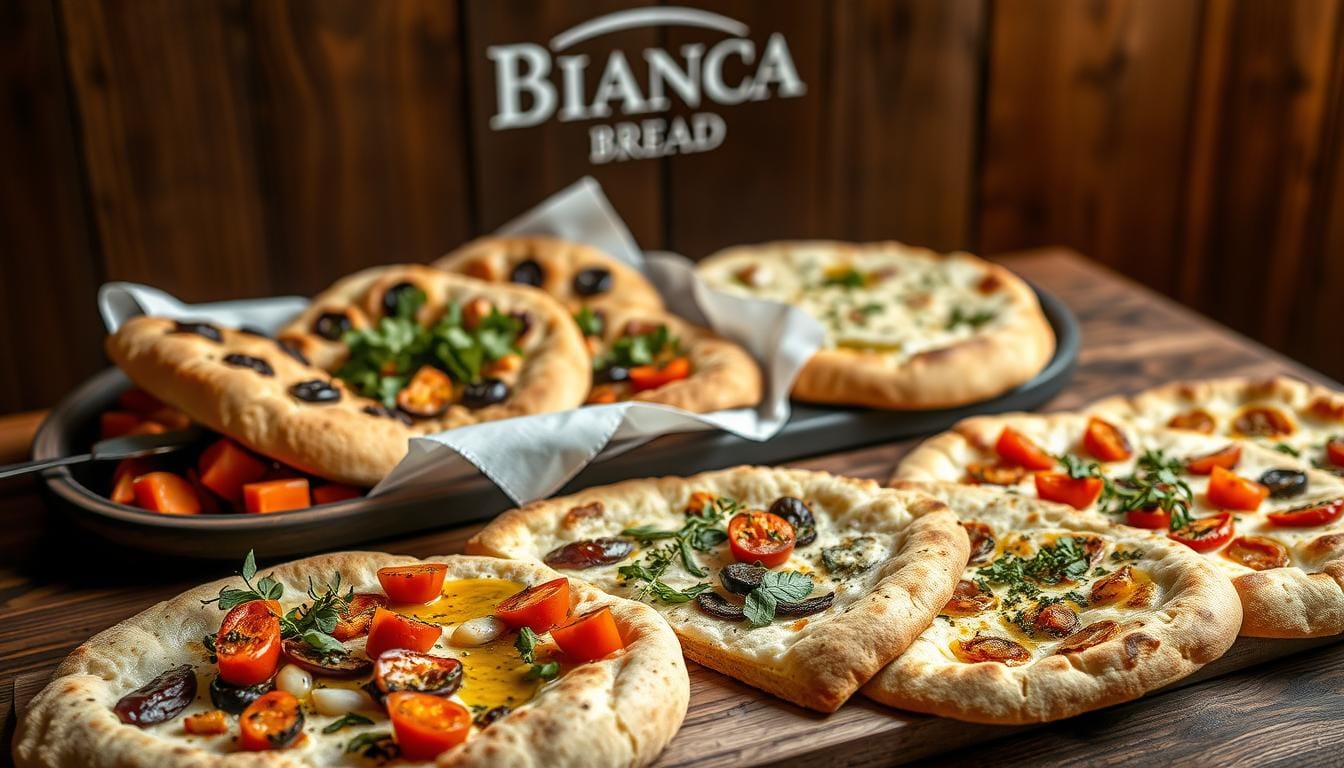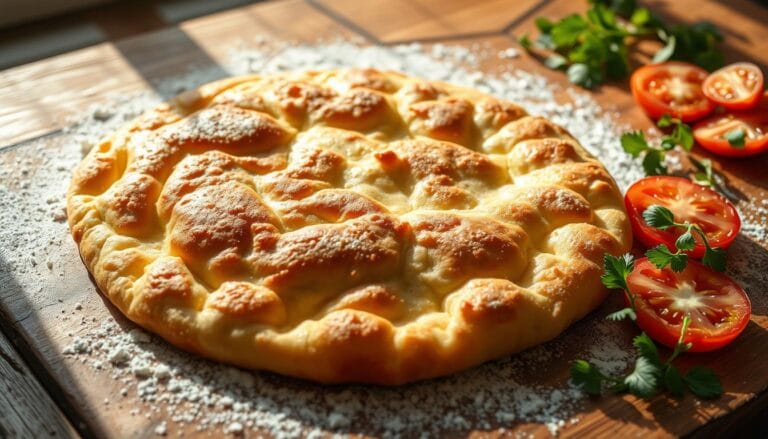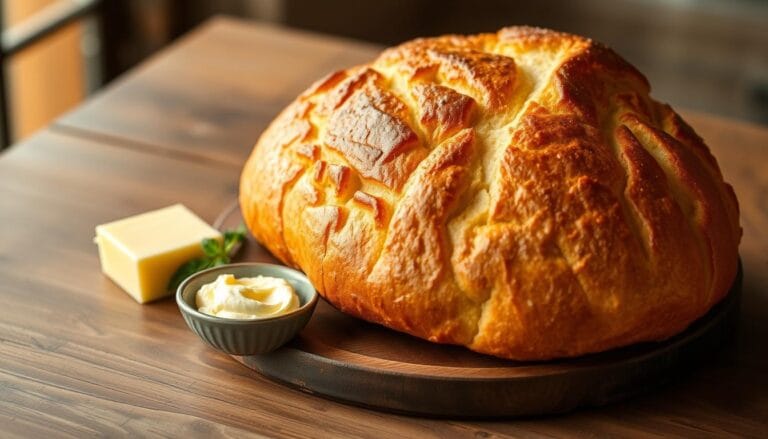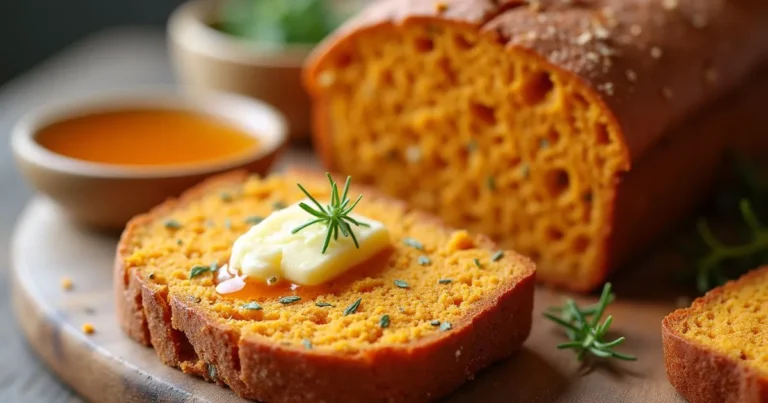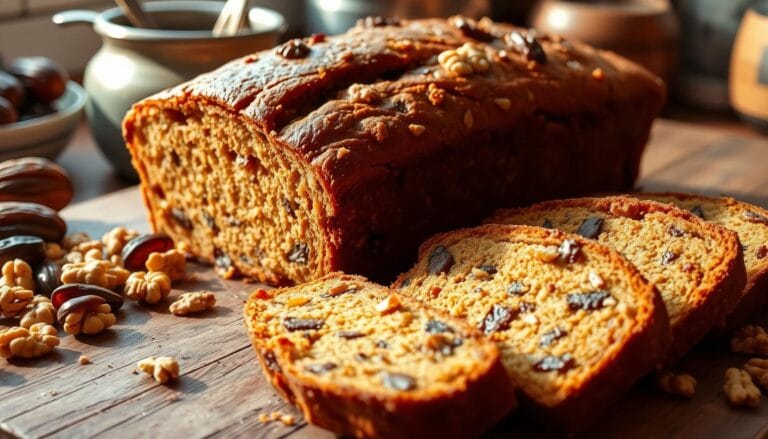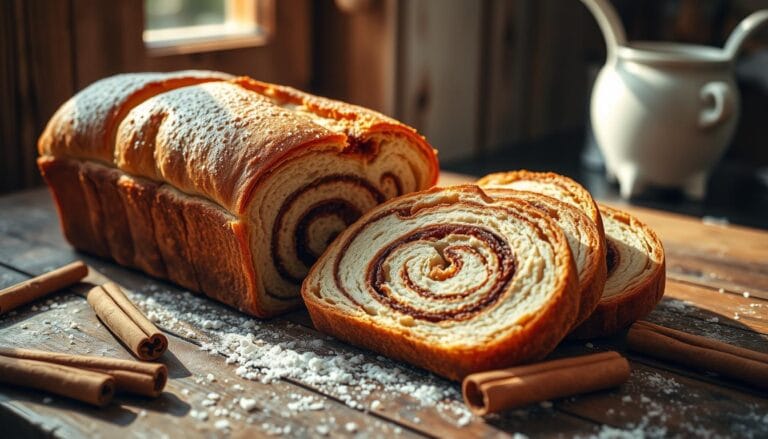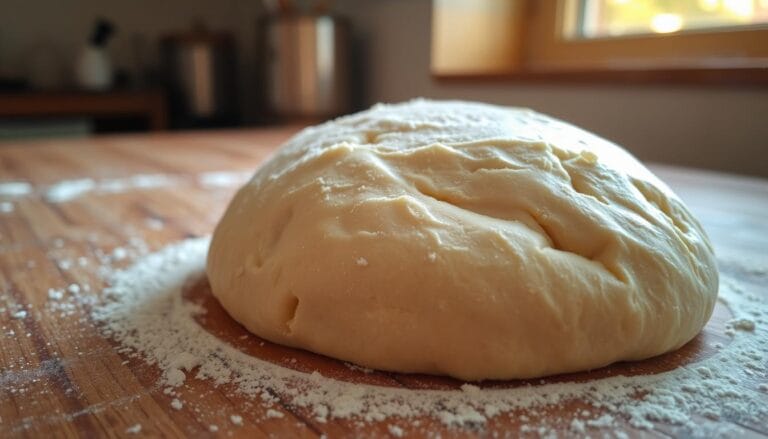Authentic Bianca Bread : Bake Italian Perfection at Home
My kitchen story started with a love for pizza bianca. It changed how I cook. Years ago, in Rome, I found this amazing Italian bianca bread.
This bread is golden and crispy, with delicate dimples. It promises a taste of authentic Italian tradition. It’s not just bread; it’s a journey to Rome’s culinary heart.
Bianca bread is more than a recipe. It opens the door to Italian cuisine’s soul. Simple ingredients become special with the right technique and tradition. Whether you bake at home or love food, making authentic pizza bianca will change your cooking.
In this guide, you’ll learn to make perfect Italian bianca bread. This flatbread can make any meal special. Get ready to improve your cooking and taste Rome’s streets.
Table of Contents
The Rich History of Italian Pizza Bianca
Explore the world of pizza bianca, a culinary gem loved for centuries. This classic Italian flatbread is deeply rooted in Roman traditions. It offers more than just a meal.
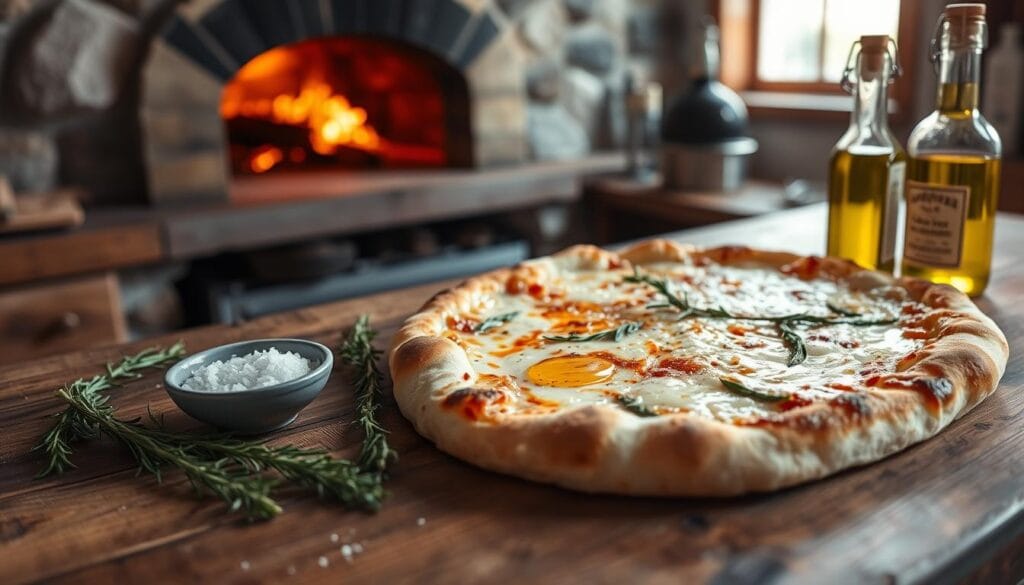
The tale of pizza bianca starts in ancient Rome’s lively streets. Here, simple ingredients became a cherished culinary art. Unlike other pizzas, this italian bianca is a thin, crispy flatbread. It’s brushed with olive oil and sprinkled with salt.
Origins in Roman Culinary Tradition
Roman bakers made pizza bianca bread as a versatile staple. It could be enjoyed at any time of day. Its simplicity shows the genius of traditional Italian cooking:
- Created from basic ingredients: flour, water, salt, and olive oil
- Historically served as street food for working-class Romans
- Represented an affordable and delicious meal option
Evolution from Ancient Flatbread to Modern Favorite
The journey of pizza bianca shows Italian cuisine’s adaptability. From a basic food to a global favorite, it has evolved. Yet, it keeps its core qualities.
“Pizza bianca represents the soul of Roman street food – simple, honest, and profoundly delicious.”
Today, pizza bianca inspires chefs and home cooks. It connects centuries of tradition with modern creativity.
Understanding Bianca Bread Fundamentals
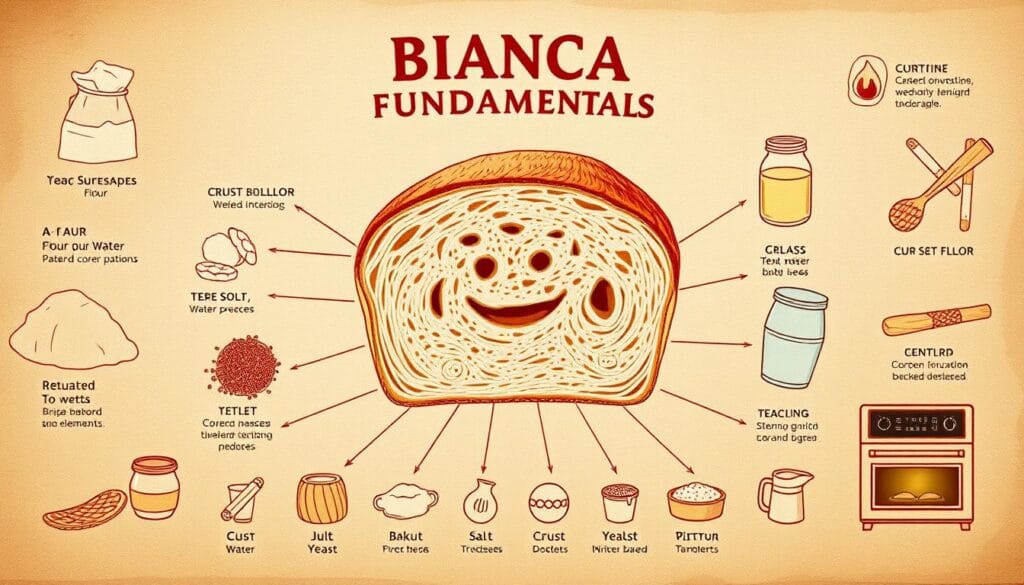
Exploring the world of bianca bread means learning about its special traits. Fans of the pane bianco bread recipe see its unique texture and taste.
The heart of bianca bread is its basic parts:
- Crisp golden outside
- Airy inside
- Simple ingredients
- Delicate olive oil touch
“Great bread is about understanding its soul, not just following a recipe.”
To make your bianca bread, focus on key steps. These steps turn simple ingredients into a work of art. The secret is in the right amount of water, careful fermentation, and baking skills.
Success with your pane bianco bread recipe comes from mastering these basics:
- Choosing the right flour
- Controlling water temperature
- Handling the dough right
- Knowing when to rest
By grasping these basics, you’ll improve your bread-making. You’ll make authentic Italian-style flatbread that pleases the palate.
Essential Ingredients for Perfect Bianca Bread
Making authentic bianca bread needs the right ingredients. Each part plays a key role in creating a dish that pleases your taste. It’s all about the mix of simple things that come together to make something amazing.
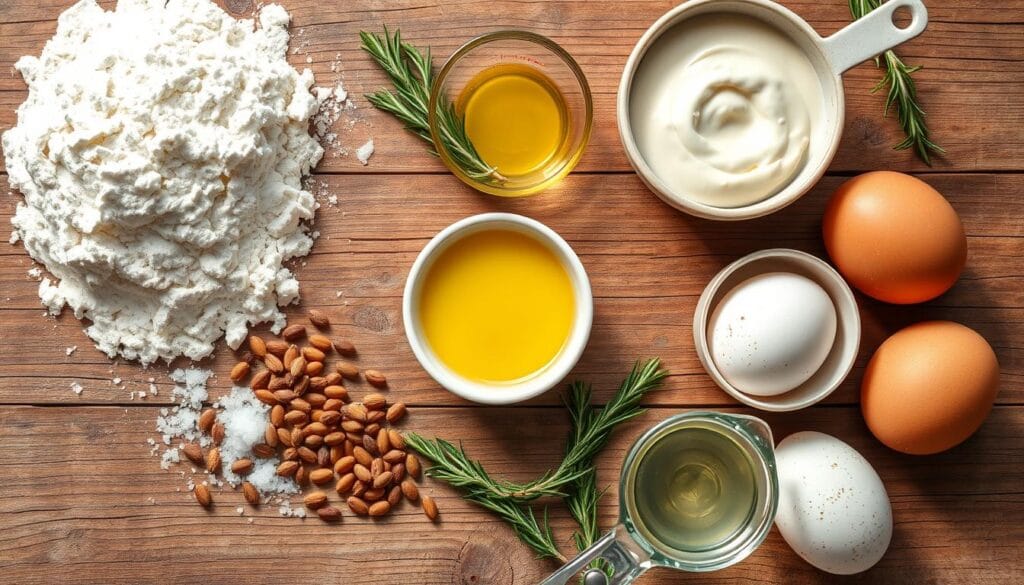
The secret to great bianca bread is in the ingredients. Let’s look at what makes this Italian bread so unique:
Quality Flour Selection
Choosing the right flour is key. You need a mix that gives both structure and taste:
- Unbleached bread flour (400 grams)
- All-purpose flour for balanced texture
- Semolina flour for authentic Italian character
The Role of Yeast and Water Temperature
Yeast is very important for making pizza bianca. Here are some things to keep in mind:
- Use room-temperature water (350 grams)
- Activate yeast at precise temperatures
- Allow proper rising time (5-7 hours)
Importance of Extra Virgin Olive Oil
Extra virgin olive oil is a must for real bianca bread. It does more than just add flavor:
- Brush 3-4 tablespoons on the dough
- Enhances texture and moisture
- Adds authentic Italian flavor profile
“The magic of bianca bread lies not just in its ingredients, but in the love and care you put into preparing them.”
By knowing and valuing each ingredient, you can make a beautiful bianca bread. It will show the true spirit of Italian baking.
Kitchen Tools and Equipment You’ll Need
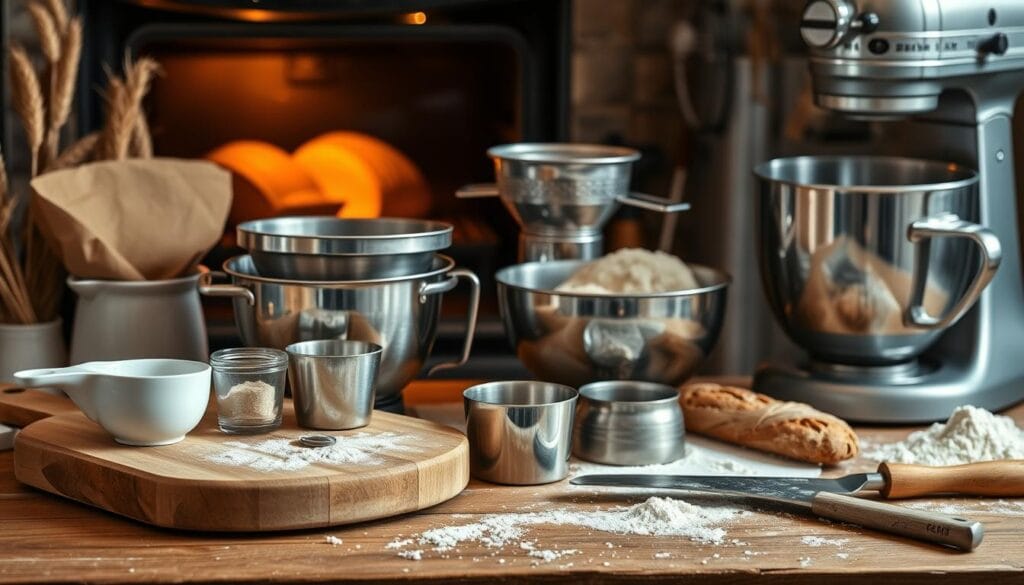
Making perfect pizza bianca bread is more than just using great ingredients. The right kitchen tools make the process enjoyable and smooth.
Here are the essential tools for making your own bianca bread:
- Stand Mixer with Dough Hook: Makes kneading easy and consistent
- Large Mixing Bowl: For the first step in making the dough
- Baking Stone or Steel: Key for getting a crispy crust
- Baker’s Peel or Overturned Baking Sheet: Helps move the dough without sticking
- Parchment Paper: Stops dough from sticking and makes cleaning up easier
You don’t need to spend a lot to get started. Many bakers begin with basic tools and add more as they get better at making pizza bianca bread.
“The right tool can turn a good recipe into an amazing culinary experience.”
Quality equipment is key to making your bianca bread recipe stand out. Think about what you already have in your kitchen. Then, add to your collection as you learn more about making bread.
- Digital Kitchen Scale: For exact ingredient amounts
- Instant-Read Thermometer: Checks water and dough temperatures
- Proofing Basket: Optional but useful for shaping dough
With these tools, you’ll be ready to make delicious pizza bianca bread that’s as good as what you find in Italian bakeries.
Step-by-Step Bianca Bread Recipe
Making the perfect pane bianco bread needs care and patience. This guide will show you how to make a real bianca bread. It will wow your family and friends.
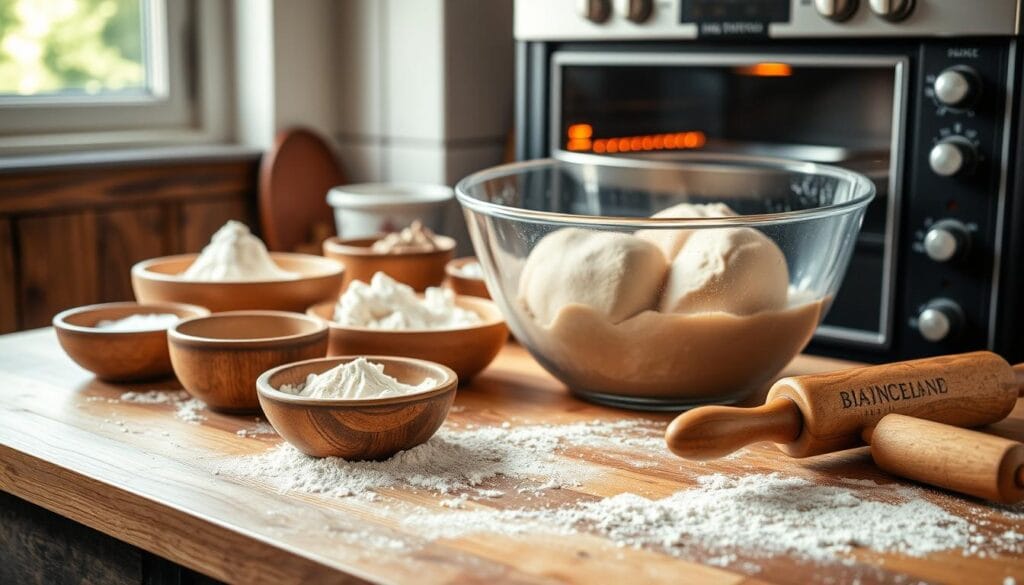
Mixing and Initial Dough Formation
Begin your bianca bread recipe by getting these key ingredients:
- 3 cups (360g) bread flour
- 2 teaspoons instant yeast
- 1 1/4 teaspoons salt
- 1 large egg
- 1/2 cup lukewarm milk
- 1/3 cup lukewarm water
- 3 tablespoons olive oil
Proper Folding Techniques
Mix the dough gently. First, mix dry ingredients, then add wet ingredients slowly. Knead the dough until it’s smooth and elastic. This takes about 8-10 minutes by hand or 5-6 minutes with a stand mixer.
“The secret to great bread is in the technique, not just the ingredients.”
Resting and Proofing Times
After mixing, let the dough rest and rise. Here’s how the proofing goes:
- First rise: 45-60 minutes at room temperature
- Optional overnight refrigeration: 8-12 hours
- Second rise: 30-45 minutes before baking
Your bianca bread recipe will give you a delicious, traditional Italian loaf. Bake at 350°F for 35-40 minutes. Cover with foil after 20-25 minutes to avoid over-browning.
The Art of Dough Shaping and Dimpling
Learning to shape bianca bread is key to making a real pizza bianca. Your fingers will be your best tool. They’ll help turn simple dough into a work of art.
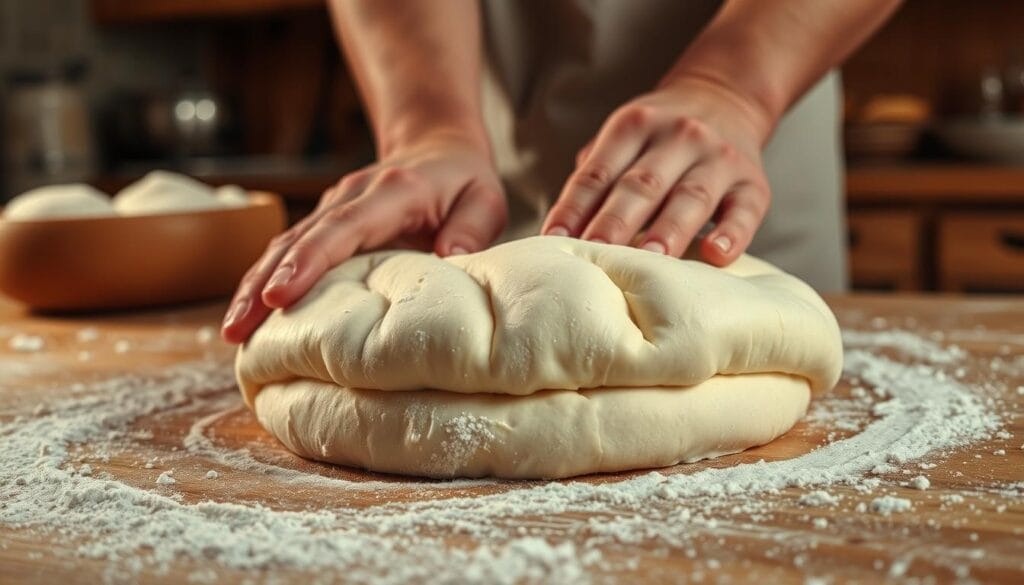
- Gently stretch the dough into a rectangular shape
- Use light, deliberate touches to maintain air pockets
- Create signature dimples across the entire surface
Dimpling does two important things for your bianca bread. It adds a texture that’s typical of Roman flatbread. It also traps olive oil and seasonings, making each bite full of flavor.
“The secret to perfect pizza bianca lies in the delicate touch of your fingertips” – Roman Baking Tradition
Try to develop a touch that stretches the dough without losing air bubbles. Start by pressing your fingertips into the dough. Make indentations all the way across, but not too deep.
- Tip: Practice makes perfect with bianca bread shaping
- Key technique: Use fingertips, not palms
- Focus: Maintain dough’s airy structure
With practice, your dough will become a beautiful canvas. It will capture the true spirit of traditional Roman flatbread.
Mastering the Perfect Crust Texture
Making the ultimate bianca bread is all about precision and knowing how temperature works. Your first step is to get the crust just right. It should be crispy on the outside and soft on the inside.
Temperature Control Tips
To make amazing bianca bread, you need to control the temperature well. Experts say to use exact oven settings to make your dough golden:
- Preheat your oven to 500°F
- Place a baking stone or steel in the middle rack
- Wait at least 30 minutes for the oven to heat up fully
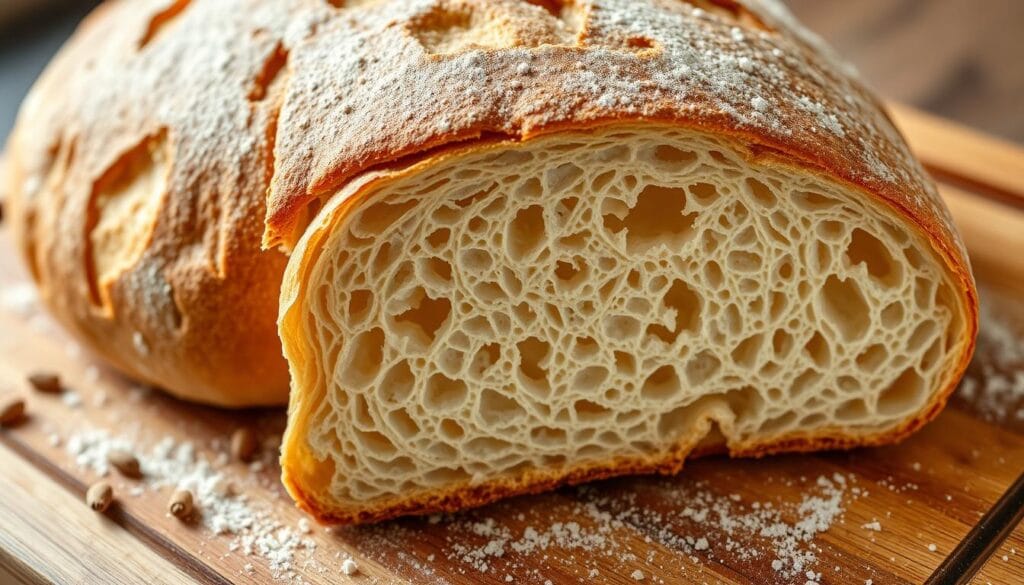
Achieving Golden Brown Perfection
To get the crust just right for pizza bianca bread, you need to know some baking secrets. You want a crust that’s golden brown and crispy. Baking time is usually 12-14 minutes, but watching for visual signs is key.
“The perfect bianca bread crust should sound hollow when tapped and display a rich, amber color.”
For the best results, try these pro tips:
- Keep a close eye on the oven temperature
- Turn the bread halfway through baking
- Use a digital thermometer to check the inside temperature
Pro tip: A crisp crust comes from good dough hydration and baking at high heat. This turns your bianca bread into a true Italian treat.
Creative Toppings and Seasonings for Bianca Bread
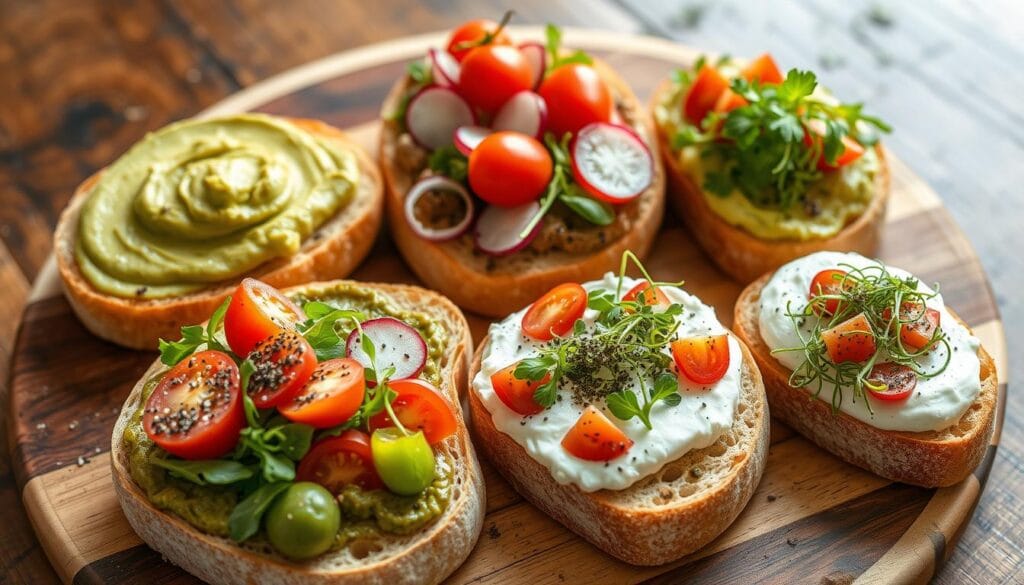
Turn your Italian bianca bread into a masterpiece with creative toppings. Bianca bread is versatile, perfect for trying new flavors. It’s a blank canvas for your taste buds.
Classic toppings can make your bianca bread stand out easily. Here are some great options:
- Extra virgin olive oil drizzled generously
- Coarse sea salt sprinkled evenly
- Fresh rosemary leaves
- Thinly sliced garlic
- Cracked black pepper
For bolder tastes, try new toppings. Truffle oil, fennel seeds, and sun-dried tomatoes add depth. Italian regions offer unique topping ideas that stay true to the bread’s roots.
“Great bread is an art form, and toppings are your palette of flavors.” – Italian Culinary Tradition
When to add toppings is key. Some are best before baking, others after. Find the right mix to highlight the bread’s softness and taste.
- Pre-bake toppings: herbs, seeds, olive oil
- Post-bake toppings: fresh herbs, cheese, delicate oils
Your bianca bread is a canvas for your creativity. It invites you to make each slice your own.
Serving Suggestions and Pairing Ideas
Discover how to make the most of your bianca bread. It can be a hit at any meal, from snacks to fancy appetizers. Your homemade pizza bianca can shine in many ways.
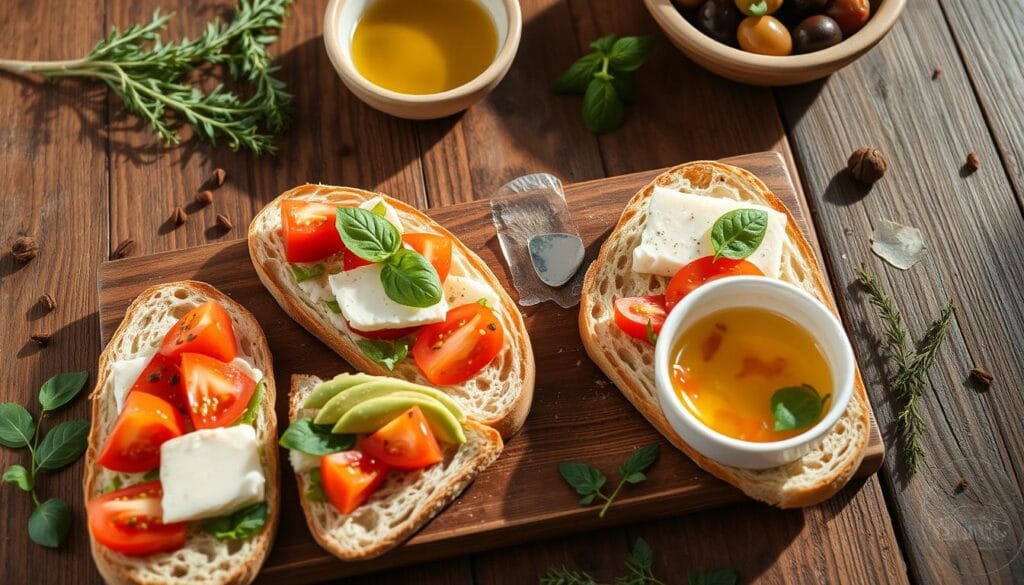
Traditional Italian Combinations
- Slice open and stuff with mortadella and creamy burrata
- Top with fresh tomatoes and mozzarella
- Pair with cured meats like prosciutto
- Serve alongside fresh ricotta and herbs
“The beauty of pizza bianca lies in its simplicity and adaptability.” – Italian Culinary Tradition
Modern Fusion Approaches
Try new flavors with bianca bread:
- Create gourmet sandwich rolls
- Use as a base for bruschetta-style appetizers
- Slice into bite-sized pieces for party platters
- Pair with international dipping sauces
Bianca bread is perfect for any occasion. It’s great for dinner parties or a quick lunch. It’s sure to delight your taste buds and impress your guests.
Storage Tips and Reheating Methods
Keeping your homemade bianca bread fresh is key. Whether it’s a pizza bianca or a classic, these tips will help. You’ll enjoy every crumb.
Storing Your Bianca Bread
Fresh bianca bread is best eaten the same day. But don’t worry if you have leftovers! Here’s how to store it well:
- Room temperature storage: Keep bread loosely wrapped in a clean kitchen towel
- Maximum room temperature storage time: 2-3 days
- Refrigeration: Not recommended for pizza bianca bread
- Freezing: Wrap tightly in plastic wrap and aluminum foil
Reheating Techniques
“The secret to great reheated bianca bread is maintaining its original crispy texture.”
Bring back your bianca bread with these tips:
- Oven method: Preheat to 400°F, reheat for 8-10 minutes
- Toaster oven: Use low setting, heat for 3-4 minutes
- Avoid microwave, which can make bread soggy
Pro tip: Place a small bowl of water in the oven while reheating. It helps keep moisture in and prevents drying out your pizza bianca bread.
Troubleshooting Common Bianca Bread Issues
Making the perfect pane bianco bread can be tough, even for skilled bakers. Knowing the common problems helps you make delicious bianca bread every time.
Every home baker faces challenges when making bianca bread. Learning to solve these problems can make baking much better.
Texture Challenges and Quick Fixes
- Dense Dough: Make sure to knead well and let it rise enough
- Sticky Texture: Adjust the flour and use ingredients at room temperature
- Crumbly Consistency: Check if the yeast is fresh and if it’s well hydrated
“Perfecting bread is about understanding its science and responding to its needs.”
Temperature-Related Solutions
Temperature is key in your pane bianco bread recipe. Different temperatures change how the dough ferments:
- Cold climates (around 70°F): Let it ferment for up to 24 hours
- Warm environments (75-85°F): Ferment for 12 hours
- Hot conditions (above 85°F): Ferment for 6-8 hours
By mastering these techniques, you’ll make stunning, authentic bianca bread that’s as good as bakery bread.
Variations on Classic Bianca Bread
Your journey into bianca bread can take you across Italy, where each region adds its own twist. You’ll find everything from thin, crispy breads to thicker focaccia style loaves. Local ingredients make each bread unique.
In Puglia, bakers add herbs like rosemary or oregano to their bread. Tuscan bakers use coarse sea salt and extra virgin olive oil for a rustic taste. Some even use ancient grains like einkorn or spelt for a nutty flavor.
Today, chefs are getting creative with bianca bread. They make gluten-free versions and add roasted veggies or artisanal cheese. The goal is to keep the bread’s crispy outside and soft inside.
Looking for something classic or modern? These variations have it all. By trying different regional styles, you’ll learn to love this Italian bread even more. Each bread has its own story, thanks to local ingredients and family recipes.
FAQ
What is the difference between pizza bianca and traditional pizza?
How long does it take to make bianca bread from start to finish?
Can I make bianca bread without a stand mixer?
What type of flour works best for bianca bread?
Is bianca bread suitable for people with dietary restrictions?
How do I know when my bianca bread is perfectly baked?
Can I freeze bianca bread?
What are some traditional ways to serve bianca bread?
How can I add flavor to my bianca bread?
What’s the best way to store freshly made bianca bread?
Leave a Review
There are no reviews yet. Be the first one to write one.

